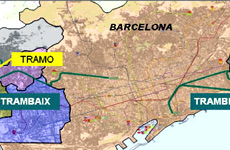
Categories
Publications
Modelization of the Track-Tramway Interaction
12/1/2011

Author/s: Susana Anacleto Lupiáñez
In spite of tramway infrastructure’s spread over the last few years, all the countries having a tramway or a light rail network suffer from lack of specific standards for the construction and the maintenance of their superstructure. This fact has lead to practices as the direct adoption or the extrapolation of geometric limit values from conventional railways, but it does not exists any clear criteria to justify the tolerances that are finally demanded to tramway constructors.
Given the obvious differences between conventional and urban railway lines with regard to axle loads, traffic homogeneity, service speed, minimum radius of curvature, platform stiffness, etc., both the limit values of defects demanded by the authorities for new track reception and the ones for maintenance operations appear to be too strict. Consequently, a reduction in efficiency, in terms of time of works’ execution and costs, takes place.
Among the main goals of the thesis, there is the definition of a methodology which allows to estimate appropriate limit values starting from a geometric track defect record. These geometric tolerances must be defined fulfilling the condition of guaranteeing certain level of vehicle ride comfort. The application of comfort criteria to the calculation of track defects’ limit values is precisely the original piece of this study, since the criterion of security (risk of derailment) is the one which traditionally governs track quality standards.
Keywords: Railway engineering, track geometry, tramway, track-vehicle interaction, geometric tolerance, geometric limits, passenger comfort, traveling comfort.
Publication: Vía Libre Railway Research Nº 2 - November 2011, pp. 47-60
Download paper »


